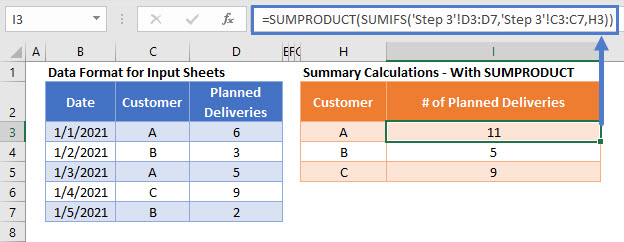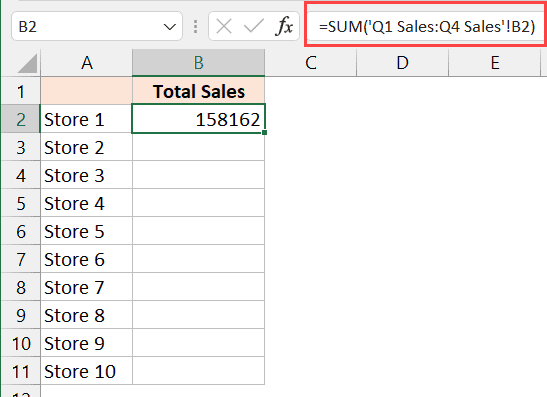5 Ways to Sum Cells from Different Excel Sheets

Understanding how to efficiently sum data from multiple Excel sheets can significantly enhance productivity, particularly when dealing with large datasets or financial models. Whether you're consolidating data, analyzing trends, or preparing reports, this guide will walk you through five distinct methods to sum cells from different sheets within Excel.
Method 1: Using Direct Cell References

One of the simplest methods to sum cells from different sheets involves direct cell references. Here's how you can do it:
- Step 1: Go to the cell where you want to display the sum.
- Step 2: Type in the formula:
=SheetName1!CellAddress + SheetName2!CellAddress. For example, if you want to sum cell B5 from "Sheet1" and cell C6 from "Sheet2," you would type:=Sheet1!B5 + Sheet2!C6. - Step 3: Press Enter. Excel will calculate the sum instantly.
🔍 Note: Ensure the cell references are correct and the sheet names are spelled accurately to avoid errors.
Method 2: Using the SUM Function with Multiple Sheets

If you need to sum the same cell across multiple sheets, this method leverages Excel's SUM function to simplify the process:
- Step 1: In a blank cell, start your formula with
=SUM(. - Step 2: Add cell references from different sheets inside the SUM function separated by commas. For example:
=SUM(Sheet1!B5, Sheet2!B5, Sheet3!B5). - Step 3: Close the parentheses and press Enter. Excel will sum all these cells together.
Method 3: Creating a Summary Sheet

For extensive data handling, creating a summary sheet can be efficient. Follow these steps:
- Step 1: Open or create a new sheet in your workbook and name it "Summary."
- Step 2: In the Summary sheet, reference cells from other sheets using direct cell references or the SUM function.
- Step 3: Use formulas like
=SUM(Sheet1:Sheet3!B5)to sum a range of cells from multiple sheets at once.
Method 4: Using 3D References

3D References allow you to sum cells across sheets with a single formula, making it ideal for standardized data:
- Step 1: Select the cell where you want to display the sum.
- Step 2: Type the formula:
=SUM(FirstSheet:LastSheet!CellAddress). Replace "FirstSheet" and "LastSheet" with the actual names of your sheets, and "CellAddress" with the specific cell you're summing. For example,=SUM(Jan:Dec!B5)would sum all B5 cells from January to December. - Step 3: Press Enter, and Excel will calculate the sum for you.
Method 5: Using VLOOKUP with Multiple Sheets

If your goal is to sum based on specific criteria across multiple sheets, the VLOOKUP function paired with SUM can be extremely useful:
- Step 1: In your summary sheet or a dedicated cell, start with a VLOOKUP function to find the value you're looking for.
- Step 2: Use the SUM function to sum the results of your VLOOKUP. For instance, if you're looking for a product's sales across sheets:
-
=SUM(VLOOKUP("ProductID", Sheet1!A2:B100, 2, FALSE), VLOOKUP("ProductID", Sheet2!A2:B100, 2, FALSE))
-
- Step 3: Press Enter to get your sum.
In summary, mastering these five methods of summing cells from different Excel sheets allows for a more dynamic and comprehensive data analysis. From direct references for simple sums to more complex VLOOKUP functions, you now have the tools to handle data aggregation in Excel effectively. Remember to:
- Ensure cell and sheet names are correctly spelled.
- Use 3D References for summing across sheets if your data is consistently formatted.
- Create summary sheets for easier management of complex datasets.
- Apply VLOOKUP with SUM for criterion-based summing.
These techniques not only streamline your workflow but also enhance your ability to analyze data across multiple sheets, leading to more informed decision-making.
What is the benefit of using 3D References in Excel?

+
3D References allow you to perform operations across multiple sheets quickly. This is particularly useful when dealing with similar data structures over time, like monthly sales reports, where each month is on a separate sheet.
How can I sum cells based on specific criteria across sheets?

+
Use VLOOKUP in combination with SUM functions. First, use VLOOKUP to locate the cells with your criteria, then apply SUM to those results to get the sum across sheets.
Are there limitations to using these methods for summing data?

+
The main limitations include data consistency across sheets (like cell references or format), the complexity of formula management in large workbooks, and potential performance issues with very large datasets or numerous sheets.
Can I automate the process of summing across sheets?

+
Yes, automation can be achieved through Excel’s macro capabilities. You can record macros to automate repetitive summing tasks or write VBA code for more customized solutions.
What should I do if my workbook has many sheets?

+
Consider creating a summary sheet and using 3D References to sum data across multiple sheets at once. This reduces complexity and potential errors when managing large workbooks.



